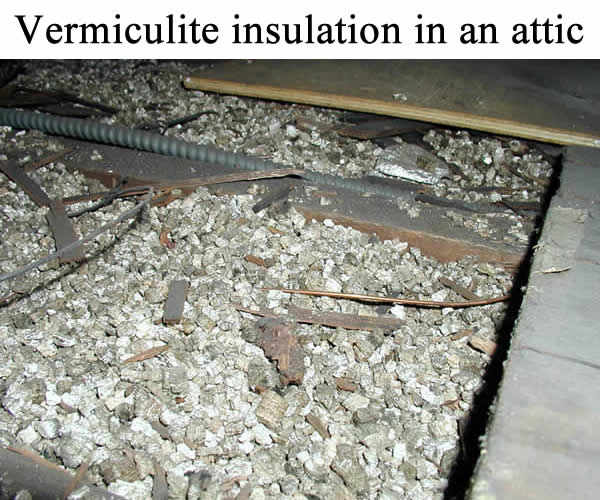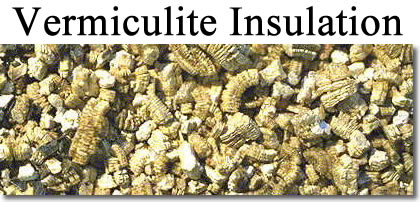Asbestos
- Asbestos Home
- Did You Know
- Enforcement
- Professionals
- Find a Contractor or Consultant
- Look up Individual Asbestos Licenses
- Asbestos Licensing
- Floor Tile Removal
- Homeowner Information
- Laboratories
- Products Containing Asbestos
- Schools
- Work Practices
- File a Complaint Related to Asbestos
- Minnesota Statutes and Rules
- Resources
- Contact us
Related Topics
Environmental Health Division
Vermiculite Insulation
Vermiculite is a naturally occurring mineral compound that expands when heated. A member of the phyllosilicate group of minerals, it resembles mica in appearance. In its pure form, vermiculite is clean, odorless, nontoxic and sterile. Recent findings about vermiculite ore contaminated with tremolite asbestos have caused concern over possible health effects for workers and others who had long-term contact.
Click on images below to enlarge
 |  |
How does asbestos cause health problems?
For asbestos to cause harmful health effects, it must be present as a tiny fiber that could be inhaled or ingested. When disturbed, asbestos breaks down into fibers 1,200 times thinner than a human hair. If these fibers are inhaled, they become trapped in lung tissue or in tissue lining the lungs and cause scarring. Asbestos fibers can cause respiratory system and lung diseases, including cancer. There is no known safe level of asbestos exposure.
How do I know if there is vermiculite insulation in my home?
Vermiculite attic insulation is a pebble-like, pour-in product and is usually light-brown, gray, or gold in color. It may have shiny flakes, and/or small accordion-like pieces (see photos above). You can also check for markings on the material or its packaging. One common brand was called Zonolite.
What should I do if I have vermiculite attic insulation?
Leave it alone. If vermiculite insulation is disturbed, it may release asbestos fibers into the air. At this point the safest and easiest option for intact insulation is to leave it alone. If the insulation is exposed or spilling into living areas, immediate steps should be taken to seal the cracks. If you want the material removed, the Minnesota Department of Health strongly recommends using a Minnesota-licensed asbestos contractor for the protection of your family's health. These contractors use special removal techniques and equipment to remove the asbestos safely. They will also perform air monitoring to determine if the indoor air meets acceptable standards at the completion of the project.
Vermiculite and gardening use
Not all vermiculite products contain asbestos, but some do. An EPA study showed some vermiculite products contain low levels of asbestos. Asbestos is found primarily in the unmixed vermiculite product although some was found in pre-mixed potting soils. For consumers using vermiculite on an infrequent basis the health risk is low. Greenhouse workers in daily contact incur a higher level of risk.
The health risk to home gardeners from infrequent contact with vermiculite is low. Nevertheless, it is prudent to take a few simple precautions.
- Use premixed potting soil. It normally contains more moisture and less vermiculite and reduces the amount of asbestos-laden dust.
- Keep vermiculite moist while using to minimize dust and possible asbestos fibers in the air. As with any dust, breathing in large amounts of particles can cause nose and throat irritation.
- Handle the material outdoors or in a well-ventilated area.
- Avoid bringing dust into the house on clothing or shoes.
- Try alternatives such as peat, sawdust, perlite or bark.
Who can I contact for more information?
For more information about asbestos, contact the Asbestos Program at MDH through the internet or by telephone at 651-201-4620.
Other resources
Go to > top